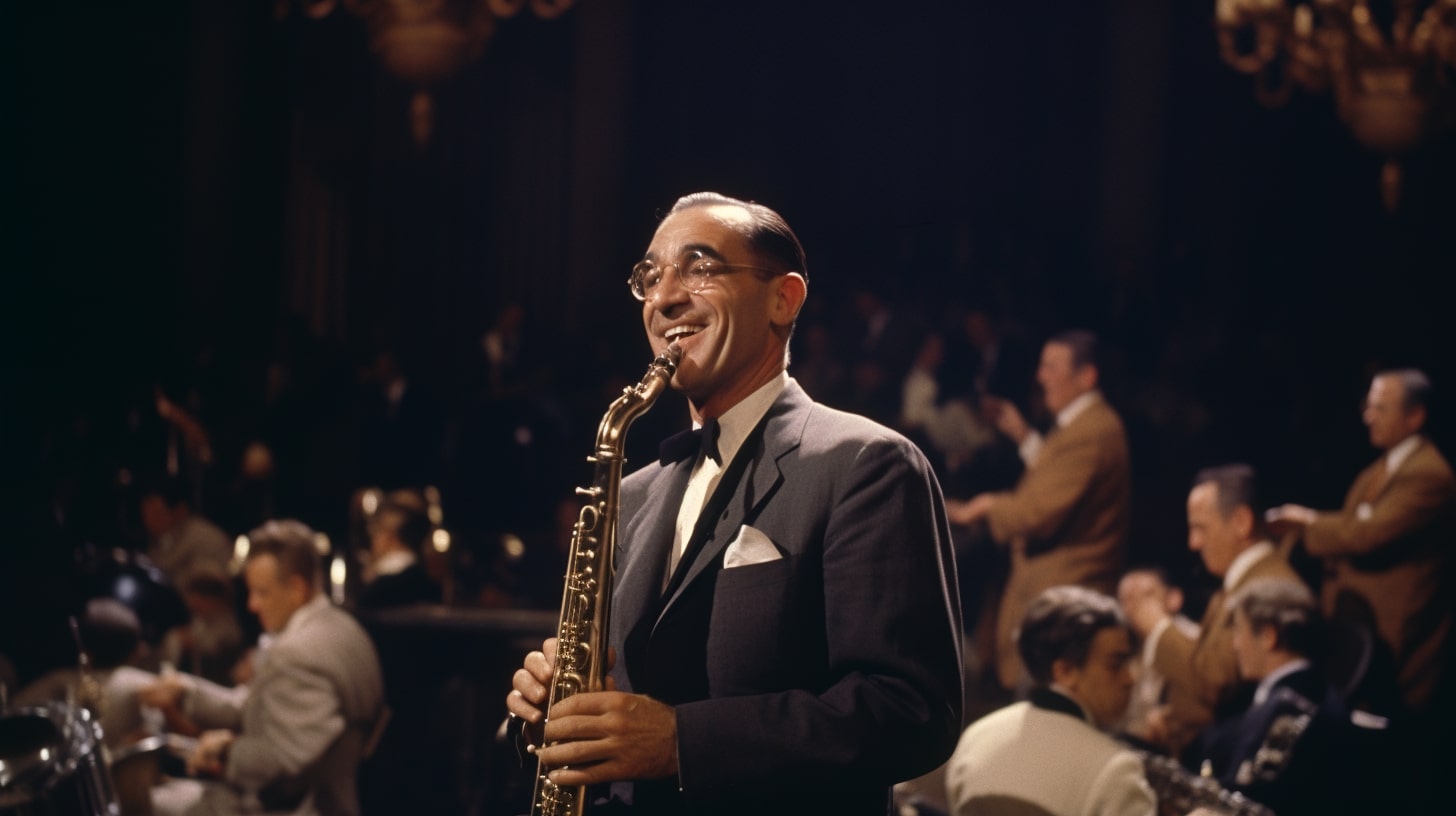Benny Goodman, a leading jazz clarinet player, and an outstanding bandleader, was a dominant figure in the Swing Era. Born Benjamin David Goodman, Benny was famously nicknamed the “King of Swing” by his bandmates due to his unique and sensational music.
Benny Goodman achieved massive success with his instrument, establishing himself as a leading figure in the world of jazz.
Contents
Early Life and Education
Childhood and Family Background
Benjamin David Goodman, known as Benny Goodman, was born on May 30, 1909, in Chicago, Illinois. He came from a family of Russian Jewish immigrants who had settled in the United States. Growing up in a large family with many siblings, Benny was exposed to music at an early age due to the musical interests of his family members.
Musical Training and Influences
Benny Goodman began his musical training at the age of 10 at the Kehelah Jacob Synagogue in Chicago. He learned to play the clarinet under the expert guidance of Franz Schoepp, a member of the Chicago Symphony. Two of Benny’s brothers also followed the path of music, studying the tuba and trumpet. Benny’s musical journey continued at the Jane Addams’ Hull House, where he played in the band and received further training, honing his skills as a clarinetist. The influences he gained from these early experiences greatly contributed to his later achievements as a bandleader, composer, and instrumentalist.
Benny Goodman Musical Career and Achievements
Benny Goodman and the Birth of Swing
Benny Goodman, born on May 30, 1909, was an American jazz clarinetist and bandleader who played a pivotal role in popularizing the swing genre. He began his music career in Chicago, learning the clarinet under the tutelage of Franz Schoepp. Goodman later joined Ben Pollack’s band in Los Angeles, where he started to gain recognition as a skilled musician. In the 1930s, he formed his own band and delivered his first number-one hit, “Moonglow.”
The King of Swing
Throughout the Swing Era (1935-1945), Benny Goodman was affectionately referred to as the “King of Swing.” He led several successful bands, often appearing on radio shows, such as “The Camel Caravan” and “The Big Broadcast of 1937.” Goodman’s bands launched the careers of notable musicians like Lionel Hampton, Gene Krupa, and Billie Holiday, whom he collaborated with through the guidance of music producer John Hammond.
Concerts and Collaborations
One of Benny Goodman’s most memorable concerts was his 1938 performance at Carnegie Hall in New York City. This event marked a groundbreaking moment for jazz as it was the first time this genre was performed at the prestigious venue. Goodman’s bands were also known for being among the first integrated jazz groups, which featured both black and white musicians during an era of racial segregation.
During his career, Benny Goodman performed with many other famous musicians and bands, including Count Basie, Duke Ellington, Peggy Lee, Tommy Dorsey, and Mel Powell. One of his most iconic performances is the song “Sing, Sing, Sing (With a Swing),” which was a hit during the height of the swing era.
These collaborations extended to numerous well-known artists, including Louis Armstrong, Glenn Miller, and Jack Teagarden. His success in the music industry led to appearances on film and radio, such as in “Hollywood Hotel” and “Syncopation.”
Classical Music Endeavors
Benny Goodman pursued his interest in classical music alongside his jazz career. He collaborated with renowned clarinetist Reginald Kell, who inspired him to adopt a new playing technique. Goodman went on to perform works by Mozart and other classical composers, further showcasing his extraordinary skills as a musician.
In summary, Benny Goodman’s long and illustrious career as a clarinetist, bandleader, and performer left an indelible mark on the world of music. He played an integral role in popularizing swing music, earning him the title of “King of Swing.” His efforts to integrate jazz bands, innovative collaborations, performances at prestigious venues like Carnegie Hall, and endeavors in classical music cemented his legacy as an influential and talented artist.
Personal Life
Relationships and Family
Benny Goodman, born in Chicago on May 30, 1909, was a renowned American clarinetist and bandleader known as the “King of Swing.” He was the ninth of twelve children born to Dora and David Goodman, Jewish immigrants from the Russian Empire. Inspired by New Orleans jazz musicians, such as Johnny Dodds and Bix Beiderbecke, Goodman began playing the clarinet at an early age. He joined the Ben Pollack Orchestra as a teenager and later became a successful session musician for the Brunswick record label.
Benny Goodman married Alice Hammond Duckworth in 1942, and the couple had two daughters: Rachel Goodman Edelson and Benjie Alice Goodman Lasseau. Alice brought a stabilizing influence on Goodman’s life and helped him in his career, particularly during his time as the star of the “Let’s Dance” radio program.
Health and Death
Despite being successful in his musical endeavors, Benny Goodman faced health challenges throughout his life. He suffered from back pain and problems with his teeth, which affected his clarinet playing. However, these issues did not deter him from a long and illustrious career that included collaborations with other legendary musicians and composers such as Harry James, Aaron Copland, Morton Gould, and Igor Stravinsky.
Benny Goodman continued to perform and record music throughout the decades, even as musical styles and technology evolved. His contributions to jazz and swing earned him numerous awards and recognitions, including a Grammy Lifetime Achievement Award, a U.S. postage stamp bearing his image, and a tribute in the form of the famous 1938 Carnegie Hall Jazz Concert.
On June 13, 1986, Benny Goodman passed away at his home in New York City due to a heart attack. He was 77 years old. Benny was buried at Long Ridge Cemetery in Stamford, Connecticut. His legacy lives on through his timeless music and pioneering efforts to promote racial integration in the world of jazz, exemplified by the Spirituals to Swing concerts and his racially integrated Let’s Dance band.
Legacy and Influence
Benny Goodman, known as the “King of Swing,” was an American clarinetist and bandleader. Throughout his career, he made significant contributions to the world of music, particularly in the swing and big band eras. Goodman’s influence spans beyond his lifetime, as he played an integral role in racial integration within the music industry by leading one of the first racially integrated bands in the United States. His impact can be seen and felt through various recognitions like a Lifetime Achievement Award and a postage stamp in his honor.
During World War II, Goodman’s music served as a source of entertainment and inspiration for many. His unique clarinet sound and innovative approach to swing music made him a popular choice for both the general public and the armed forces. Goodman’s influence went beyond national borders as his music reached international audiences, solidifying his status as a global ambassador for American music.
In 1938, Benny Goodman made history by performing at Carnegie Hall in New York City. This groundbreaking concert marked the first time a jazz band had played at the prestigious venue, bringing jazz into mainstream consciousness and elevating the genre’s status in the music world. The Carnegie Hall concert represented a significant milestone for Goodman and jazz as a whole.
Goodman’s commitment to racial integration within his bands played a crucial role in breaking down racial barriers in the music industry. Historically, musicians were often segregated, but Goodman defied these conventions and hired talented African American musicians, such as pianist Teddy Wilson and vibraphonist Lionel Hampton. This pioneering act served as a model for others in the industry and contributed significantly to the advancement of racial equality in music.
Throughout his career, Benny Goodman received numerous accolades and recognitions. In 1986, he was honored with a Lifetime Achievement Award from the National Academy of Recording Arts and Sciences, highlighting his influence and impact on the music industry. Additionally, in 1996, the United States Postal Service issued a commemorative postage stamp featuring Goodman’s image, further acknowledging his contributions to American music.
In summary, Benny Goodman’s impact as a clarinetist and bandleader extends far beyond his musical accomplishments. His legacy includes groundbreaking performances, contributions to racial integration in the music industry, and the recognition he received both during his life and after.


